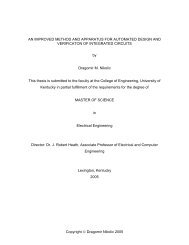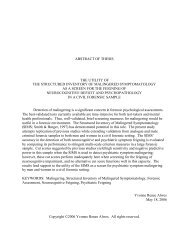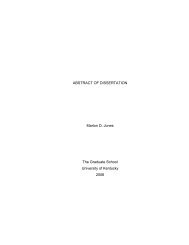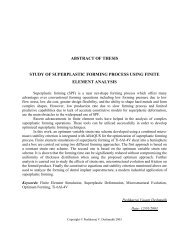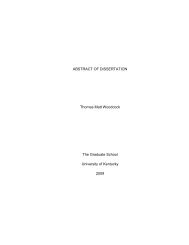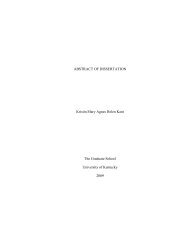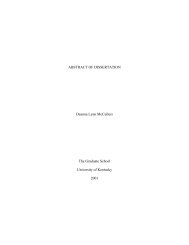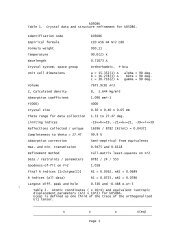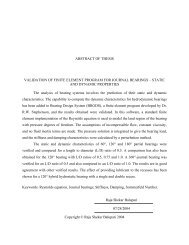Ambystoma - University of Kentucky Libraries
Ambystoma - University of Kentucky Libraries
Ambystoma - University of Kentucky Libraries
You also want an ePaper? Increase the reach of your titles
YUMPU automatically turns print PDFs into web optimized ePapers that Google loves.
investigated by searching A. mexicanum limb regeneration ESTs against UNIGENE<br />
zebrafish fin regeneration ESTs (Figure 2.3). This search identified 1357 significant<br />
BLAST hits (TBLASTX; E 400,000 zebrafish ESTs that were sampled<br />
from non-regenerating tissues was then performed to assess whether any <strong>of</strong> these<br />
potential regeneration homologues were represented uniquely in limb and fin<br />
regeneration databases (and not in databases derived from other zebrafish tissues). These<br />
comparisons revealed 43 that were unique to the zebrafish regeneration database (Table<br />
2.10). Conceivably, these 43 ESTs may represent transcripts important to appendage<br />
regeneration. For example, this search identified several genes (e.g. hspc128, pre-B-cell<br />
colony enhancing factor 1, galectin 4, galectin 8) that may be expressed in progenitor<br />
cells that proliferate and differentiate during appendage regeneration. Overall, these<br />
results suggest that regeneration is achieved largely through the reiterative expression <strong>of</strong><br />
genes having additional functions in other developmental contexts, however a small<br />
number <strong>of</strong> genes may be expressed uniquely during appendage regeneration.<br />
DNA sequence polymorphisms within and between A. mexicanum and A. t. tigrinum<br />
The identification <strong>of</strong> single nucleotide polymorphisms (SNPs) within and between<br />
orthologous sequences <strong>of</strong> A. mexicanum and A. t. tigrinum is needed to develop DNA<br />
markers for genome mapping (Parichy et al, 1999), quantitative genetic analysis (Voss<br />
and Shaffer et al, 1997), and population genetics (Fitzpatrick and Shaffer, 2004). The<br />
frequency <strong>of</strong> within species polymorphism was estimated for both species by calculating<br />
the frequency <strong>of</strong> SNPs among ESTs within the 20 largest contigs (Tables 2.6 and 2.7).<br />
These analyses considered a total <strong>of</strong> 30,638 base positions for A. mexicanum and 18,765<br />
base positions for A. t. tigrinum. Two classes <strong>of</strong> polymorphism were considered in this<br />
analysis: those occurring at moderate (identified in 10–30% <strong>of</strong> the EST sequences) and<br />
high frequencies (identified in at least 30% <strong>of</strong> the EST sequences). Within the A.<br />
mexicanum contigs, 0.49% and 0.06% <strong>of</strong> positions were polymorphic at moderate and<br />
high frequency, while higher levels <strong>of</strong> polymorphism were observed for A. t. tigrinum<br />
(1.41% and 0.20%). Higher levels <strong>of</strong> polymorphism are expected for A. t. tigrinum<br />
because they exist in larger, out-bred populations in nature.<br />
19



